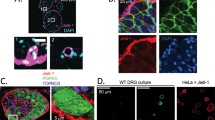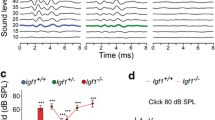Abstract
Postnatal mice lacking neurotrophin-3 (NT3) are deficient in Merkel cells of touch domes and whisker follicles. We examined the mechanism of Merkel cell loss by immunocytochemistry and electron microscopy. Merkel cell of whisker follicles of NT3 null newborns exhibited decreased immunoreactivity for cytokeratin 8 and contained apoptotic bodies that were positive for cleaved caspase-3, a marker of active apoptosis. By electron microscopy, the Merkel cells displayed aggregation of chromatin along the nuclear membrane, with the marginated chromatin forming caps at the periphery of the nucleus. Ribosomes aggregated in the cytoplasm, while dense core granules characteristic of Merkel cells were still discernible. Finally, the Merkel cells and their nuclei fragmented into apoptotic bodies. None of the apoptotic Merkel cells were contacted by nerve fibers, and their desmosomal contacts with surrounding keratinocytes disappeared. After postnatal day 6 apoptotic Merkel cells were no longer observed, and the number of surviving Merkel cells was severely reduced. They were flat and contained few osmiophilic granules. We conclude that perinatal apoptosis is responsible for the loss of Merkel cells lacking innervation in NT3 null mice.




Similar content being viewed by others
References
Airaksinen MS, Koltzenburg M, Lewin GR, Masu Y, Helbig C, Wolf E, Brem G, Toyka KV, Thoenen H, Meyer M (1996) Specific subtypes of cutaneous mechanoreceptors require neurotrophin-3 following peripheral target innervation. Neuron 16:267–295
Albers KM, Perrone TN, Goodness TP, Jones ME, Green MA, Davis BM (1996) Cutaneous overexpression of NT-3 increases sensory and sympathetic neuron number and enhances touch dome and hair follicle innervation. J Cell Biol 134:487–497
Buchman VL, Davies AM (1993) Different neurotrophins are expressed and act in a developmental sequence to promote the survival of embryonic sensory neurons. Development 118:989–1001
Cronk KM, Wilkinson GA, Grimes R, Wheeler EF, Jhaveri S, Fundin BT, Silos-Santiago I, Tessarollo L, Reichardt LF, Rice FL (2002) Diverse dependencies of developing Merkel innervation on the trkA and both full-length and truncated isoforms of trkC. Development 129:3739–3750
Davies A, Lumsden A (1984) Relation of target encounter and neuronal death to nerve growth factor responsiveness in the developing mouse trigeminal ganglion. J Comp Neurol 223:124–137
English KB (1977) The ultrastructure of cutaneous type I mechanoreceptors (Haarscheiben) in cats following denervation. J Comp Neurol 172:137–163
English KB, Kavka-Van Norman D, Horch K (1983) Effects of chronic denervation in type I cutaneous mechanoreceptors (Haarscheiben). Anat Rec 207:79–88
English KB, Wang ZZ, Stayner N, Stensaas LJ, Martin H, Tuckett RP (1992) Serotonin-like immunoreactivity in Merkel cells and their afferent neurons in touch domes from the hairy skin of rats. Anat Rec 232:112–120
Ernfors P, Lee KF, Kucera J, Jaenisch R (1994) Lack of neurotrophin-3 leads to deficiencies in the peripheral nervous system and loss of limb proprioceptive afferents. Cell 77:503–512
Farinas I, Yoshida CK, Backus C, Reichardt LF (1996) Lack of neurotrophin-3 results in death of spinal sensory neurons and premature differentiation of their precursors. Neuron 17:1065–1078
Fundin BT, Silos-Santiago I, Ernfors P, Fagan AM, Aldskogius H, DeChiara TM, Phillips HS, Barbacid M, Yancopoulos GD, Rice FL (1997) Differential dependency of cutaneous mechanoreceptors on neurotrophins, trk receptors, and P75 LNGFR. Dev Biol 190:94–116
Grim M, Halata Z (2000) Developmental origin of avian Merkel cells. Anat Embryol 202:401–410
Haeberle H, Fujiwara M, Chuang J, Medina MM, Panditrao MV, Bechstedt S, Howard J, Lumpkin EA (2004) Molecular profiling reveals synaptic release machinery in Merkel cells. Proc Natl Acad Sci USA 101:14503–14508
Halata Z, Grim M, Christ B (1990) Origin of spinal cord meninges, sheaths of peripheral nerves, and cutaneous receptors including Merkel cells. An experimental and ultrastructural study with avian chimeras. Anat Embryol 182:529–537
Halata Z, Grim M, Bauman KI (2003) Friedrich Sigmund Merkel and his “Merkel cell”, morphology, development, and physiology: review and new results. Anat Rec 271A:225–239
Hartschuh W, Weihe E (1988) Multiple messenger candidates and marker substances in the mammalian Merkel cell-axon complex: a light and electron microscopic immunohistochemical study. Prog Brain Res 74:181–187
Huang EJ, Reichardt LF (2001) Neurotrophins: roles in neuronal development and function. Annu Rev Neurosci 24:677–736
Iggo A, Muir AR (1969) The structure and function of a slowly adapting touch corpuscle in hairy skin. J Physiol 200:763–796
Krimm RF, Davis BM, Woodbury CJ, Albers KM (2004) NT3 expressed in skin causes enhancement of SA1 sensory neurons that leads to postnatal enhancement of Merkel cells. J Comp Neurol 471:352–360
Laczko J, Levai G (1975) A simple differential staining method for semi-thin sections of ossifying cartilage and bone tissue embedded in epoxy resin. Mikroskopie 31:1–4
Mehlen P, Thibert C (2004) Dependence receptors: between life and death. Cell Mol Life Sci 61:1854–1866
Moll I, Moll R (1992) Early development of human Merkel cells. Exp Dermatol 1:180–184
Moll I, Moll R, Franke WW (1986) Formation of epidermal and dermal Merkel cells during human fetal skin development. J Invest Dermatol 87:779–787
Moll I, Kuhn C, Moll R (1995) Cytokeratin 20 is a general marker of cutaneous Merkel cells while certain neuronal proteins are absent. J Invest Dermatol 104:910–915
Pasche F, Merot Y, Carraux P, Saurat JH (1990) Relationship between Merkel cells and nerve endings during embryogenesis in the mouse epidermis. J Invest Dermatol 95:247–251
Schecterson LC, Bothwell M (1992) Novel roles for neurotrophins are suggested by BDNF and NT-3 mRNA expression in developing neurons. Neuron 9:449–463
Slee EA, Adrain C, Martin SJ (2001) Executioner caspase-3, caspase-6, and caspase-7 perform distinct, non-redundant roles during the demolition phase of apoptosis. J Biol Chem 276:7320–7326
Szeder V, Grim M, Halata Z, Sieber-Blum M (2003a) Neural crest origin of mammalian Merkel cells. Dev Biol 253:258–263
Szeder V, Grim M, Kucera J, Sieber-Blum M (2003b) Neurotrophin-3 signaling in mammalian Merkel cell development. Dev Dyn 228:623–629
Wilkinson GA, Farinas I, Backus C, Yoshida CK, Reichardt LF (1996) Neurotrophin-3 is a survival factor in vivo for early mouse trigeminal neurons. J Neurosci 16:7661–7669
Zelena J (1994) Nerves and mechanoreceptors. Chapmann and Hall, London
Acknowledgments
The authors thank Ms. Brigitte Asmus (Hamburg) and Ms. Markéta Pleschnerová (Prag) for excellent technical assistance and Mr. Rob Quazi (Boston) for genotyping. This study was supported by DAAD (ZH), the Veterans Administration (JK), NSF Grant#0077922 (JK), GAUK Grant 2/2004/C (TK), and VZ1111-00003-3 project of the Ministry of Education of the Czech Republic (MG).
Author information
Authors and Affiliations
Corresponding author
Rights and permissions
About this article
Cite this article
Halata, Z., Kucera, J., Kucera, T. et al. Apoptosis of Merkel cells in neurotrophin-3 null mice. Anat Embryol 209, 335–340 (2005). https://doi.org/10.1007/s00429-005-0455-0
Accepted:
Published:
Issue Date:
DOI: https://doi.org/10.1007/s00429-005-0455-0




